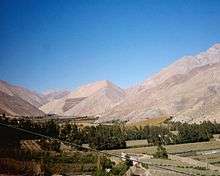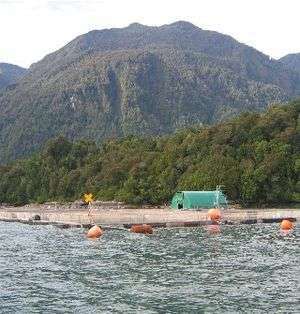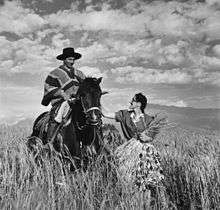Agriculture in Chile


Agriculture in Chile encompasses a wide range of different activities due its particular geography, climate, geology and human factors. Historically agriculture is one of the bases of Chile's economy, now agriculture and allied sectors—like forestry, logging and fishing—account only for 4.9% of the GDP as of 2007 and employed 13.6% of the country's labor force. Some major agricultural products of Chile include grapes, apples, pears, onions, wheat, corn, oats, peaches, garlic, asparagus, beans, beef, poultry, wool, fish and timber.[1] Due to its geographical isolation and strict customs policies, Chile is free from diseases such as Mad Cow, fruit fly and Phylloxera, this plus being located in the southern hemisphere (having quite different harvesting times compared to the Northern Hemisphere) and its wide range of agriculture conditions are considered Chile’s main comparative advantages. However, the mountainous landscape of Chile limits the extent and intensity of agriculture so that arable land corresponds only to 2.62% of the total territory.[1]
Chile’s principal growing region and agricultural heartland is the Central Valley delimited by the Chilean Coast Range in the west, the Andes in the east Aconcagua River in the north and Bío-Bío River in the south. In the northern half of Chile, cultivation is highly dependent on irrigation. South of the Central Valley, cultivation is gradually replaced by aquaculture, silviculture, sheep and cattle farming.
Agriculture by region
Norte Grande
The Norte Grande region covers most of Atacama Desert and its crop agriculture is contracted around small oases, such as Pica (Chilean name for Key lime is Limón de Pica) and Pozo Almonte. The use of water from Loa River and other streams is limited due to contamination with heavy metals from the mining industry. Some minor substistence agriculture is practised in Loa River. Recently these waters are being used for growing non-edible plants, such as flowers. In Norte Grande's Puna plateau, indigenous Aymaras practise traditional llama and alpaca herding.
Norte Chico
Norte Chico has a semi-arid climate that limits agriculture to the Transverse Valleys, namely; Choapa, Copiapó, Elqui, Limarí and Aconcagua. Most agriculture here is dependent on irrigation. Norte Chico is known for its production of grapes for Pisco and papayas. Other crops cultivated include olives and avocados .
Zona Central
Zona Central is Chile's agricultural and cultural heartland. With its mediterranean climate, Zona Central hosts the largest part of the country's wine regions. Most of Chile's premium wine regions depend on irrigation to sustain vineyards, the necessary water formed by melting snow caps in the Andes. In the developing wine regions along the Coastal Ranges and in the far south, there is not a lack of needed rainfall but vineyards owners have to deal with other factors, such as the Humboldt Current from the Pacific which can bathe a vineyard with a blanket of cool air. For the rest of Chile's wine regions, the Coastal Ranges serve as a buffer from the current and also act as a rain shadow. The vineyards in these regions are planted on the valley plains of the Andes foothills along the major rivers such as the Maipo, Rapel and Maule Rivers.[2]
Zona Sur
Wheat cultivation, cattle farming, silviculture and salmon aquaculture are the main agricultural activities of Zona Sur. In northern Zona Sur Araucania Region was known until recently as "Chile’s granary". Wheat in Araucanía continues to be the main crop; however, production of oats and lupine has increased significantly. While the area devoted to traditional crops and natural pasture has tended to shrink in Araucanía, there has been an increase in artificial and improved pasturelands. This supports a substantial mass of livestock, including beef cattle, swine, sheep, and horses, and abundant production of milk and by-products. Salmon aquaculture is Los Lagos Region largest source of jobs and main export industry. Nearly all of Chile’s, and much of the southern hemisphere, blue berry and cranberry production is concentrated in Zona Sur.
Zona Austral
In Zona Austral, sheepherding has been a major industry since the 19th century. In the Magallanes Region alone, there is an estimate of 1.5 and 2 million sheep distributed among 300 farmers as of 2006.[3] Exotic species, like reindeer, have been introduced in recent years. Agriculture in the north-western parts of Zona Austral (Aisén, Chiloé and Palena) focuses on aquaculture and silviculture and is similar to that of Zona Sur.
Evidence ranging from historical records, local agriculturalists, and DNA analyses strongly supports the hypothesis that the most widely cultivated variety of potato worldwide, Solanum tuberosum tuberosum, is indigenous to Chiloé Island and has been cultivated by the local indigenous people since before the coming of the Spanish.[4][5]
History
Agriculture is practised in Chile since pre-Hispanic times when indigenous Mapuches, Aymaras and Atacameños raised llama and alpaca livestock and cultivated beans, maize, potato and quinoa. With the arrival of the Spaniards around 1550 European plants and animals such as grapes, wheat, horses and cattle were introduced to Chile. Due to the geographical isolation of Chile and the commerce limitations imposed by the Spanish crown few new species were introduced to colonial Chile after its conquest. Nearly all of Chile's exports and imports went by Lima in Peru, which was a rich colony with little need of commerce with Chile. The 17th century came to be known as the century of the fat (Siglo del sebo), because Chile’s agricultural exports to Peru consisted mainly of animal fat and charqui.
Since Peru's croplands were affected by an earthquake and a plague in 1687, Chile became a major exporter of wheat, first to Peru but later in the 19th century to Australia and California. The wheat cultivation increased further in the 1880s, fueled by the new arable land available after the occupation of Araucanía. The wheat period ended in poor conditions coupled with decades of extensive farming without crop rotation or other techniques that prevented erosion. Erosion also resulted in several rivers being unnavigable.
Sheep were introduced to the Chilean Patagonia from the Falkland Islands in 1865 and between about 1890 and 1940, Magallanes Region became one of the world's most important sheep-raising regions, with one company (Sociedad Explotadora de Tierra del Fuego) controlling over 10,000 square kilometres in southern Chile and Argentina.
Since the liberalization of Chile's economy in the 1980s export agriculture, mainly commodity products, grew and diversified. Some products that have reached the international market in huge quantities include salmon, Chilean wine, berries and fruit.
See also
- Aquaculture in Chile
- Chilean wine
- Climate of Chile
- Drought in Chile
- Fishing in Chile
- Forestry in Chile
- White Earthquake
References
- 1 2 The World Factbook -CIA, 2008-02-27
- ↑ T. Stevenson "The Sotheby's Wine Encyclopedia" pg 543-546 Dorling Kindersley 2005 ISBN 0-7566-1324-8
- ↑ Mercopress - Sheep farming innovation in Magallanes Region 2008-02-28
- ↑ Molecular description and similarity relationships among native germplasm potatoes (Solanum tuberosum ssp. tuberosum L.) using morphological data and AFLP markers, Jaime Solano Solis et al., Electronic Journal of Biotechnology, July 2007
- ↑ Using DNA, scientists hunt for the roots of the modern potato
External links
 Media related to Agriculture in Chile at Wikimedia Commons
Media related to Agriculture in Chile at Wikimedia Commons



